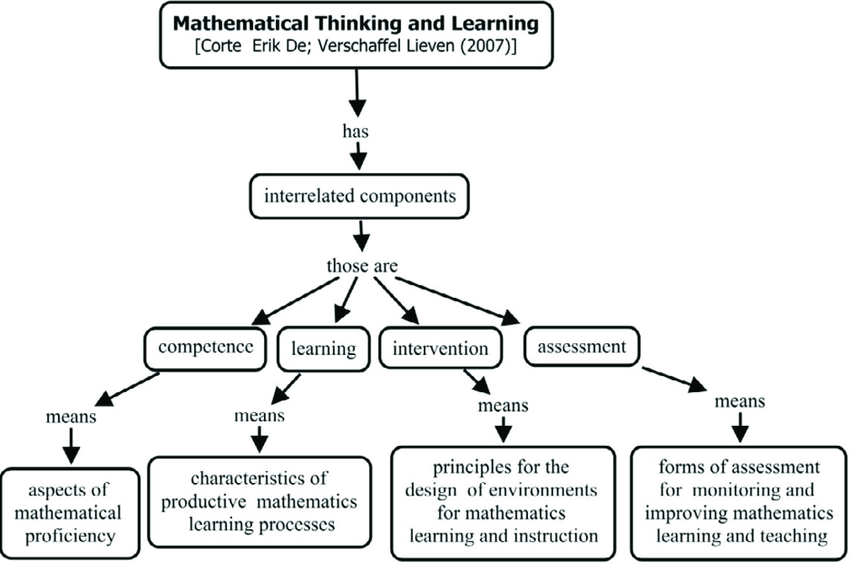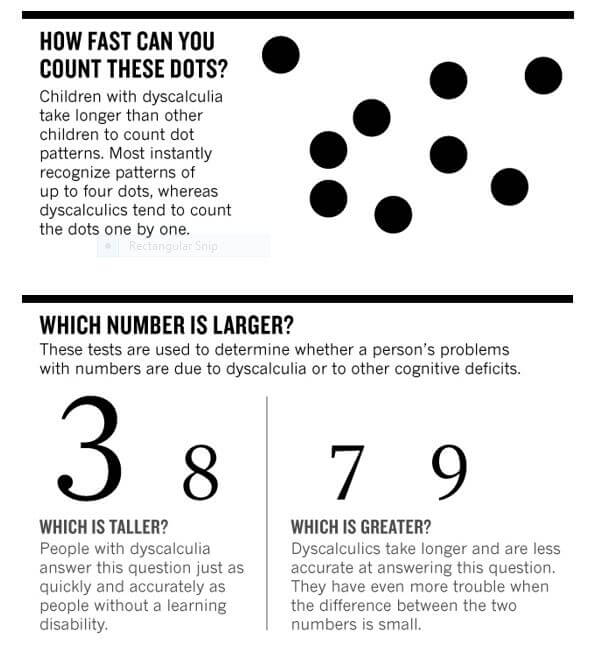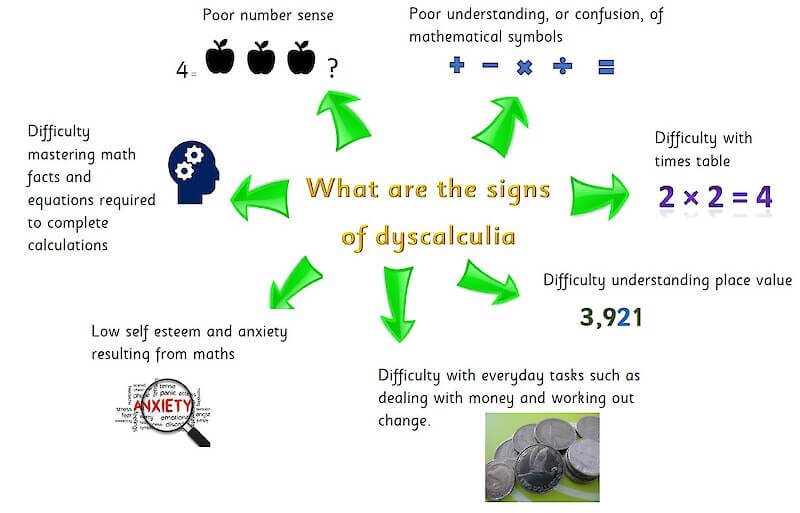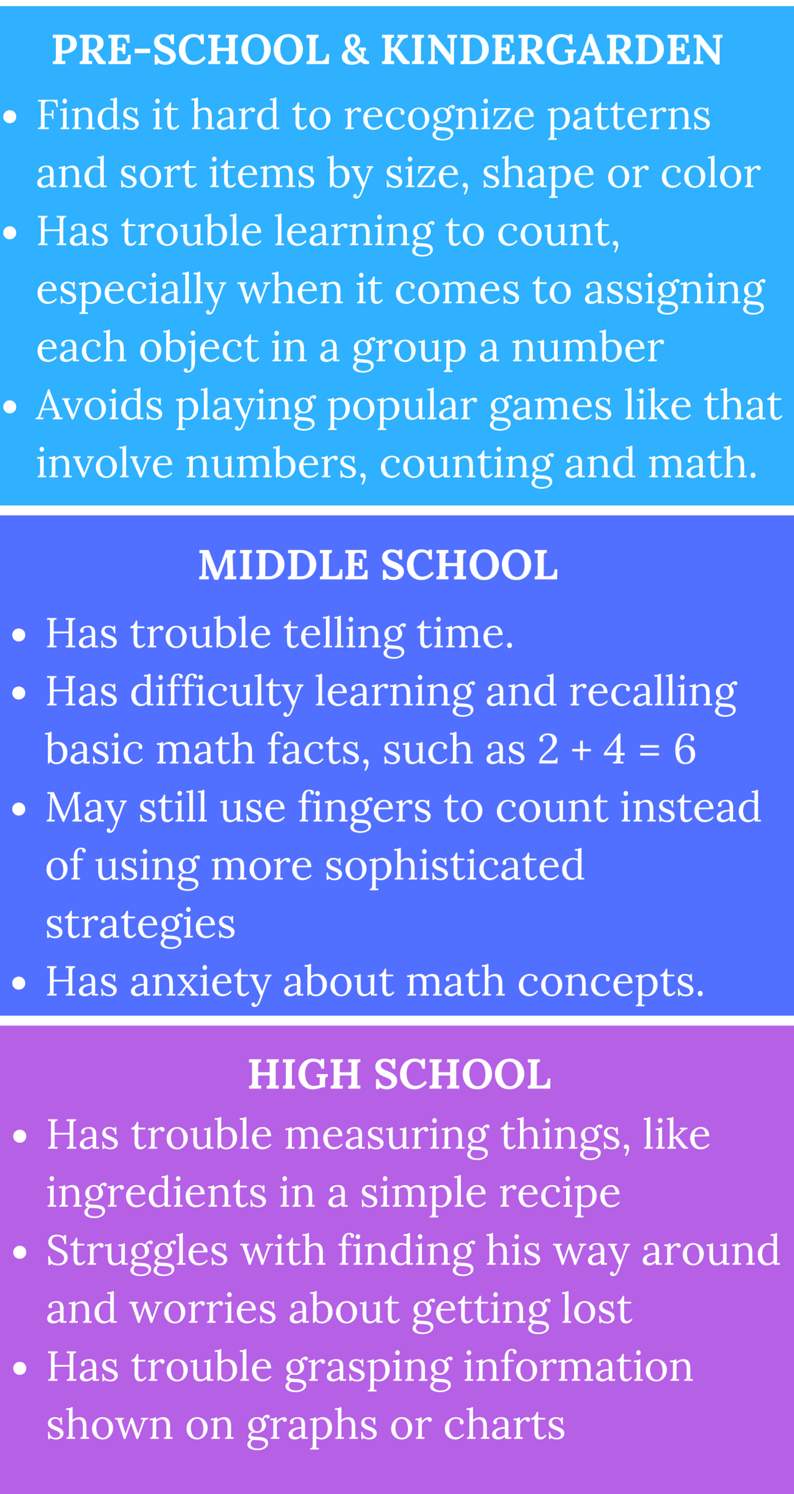Tests for Dyscalculia
Explore dyscalculia tests and how they identify mathematical learning difficulties. Learn about computation, fluency, and reasoning tests, plus support strategies.


Explore dyscalculia tests and how they identify mathematical learning difficulties. Learn about computation, fluency, and reasoning tests, plus support strategies.
Dyscalculia is a condition where someone has difficulty learning or understanding numbers. This can affect children's ability to read and write math problems, count change, and add and subtract. This brain-related condition affects about 1 in 20 children worldwide and can have significant implications in school. In 2025, our understanding of dyscalculia has grown considerably, yet many children still go undiagnosed. The symptoms usually start around age 3 and continue throughout childhood. There is no cure for dyscalculia, but there is practical support available.
This condition can often be misdiagnosed as ADHD (attention deficit hyperactivity disorder). If left untreated, dyscalculia can cause severe academic difficulties later in life. A child's academic achievement is a major source of worry for both parents and teachers. Concerns about the child's academic performance are frequently prevalent.
Around the world, many students struggle with a broad spectrum of learning disabilities and over the last few years, we have learned a lot more about these conditions. A learning disability is a neurological disorder or learning impairment that affects a child's brain capacity to send, receive, and process information.
The general daily skills that a child learns might be impacted. If you have been through our other articles you will be aware of some of the different types of learning disabilities. A child may experience multiple learning disabilities at once which include:
Despite not being a familiar name, dyscalculia is one of the most common learning disabilities you can expect to encounter in primary school. Dyscalculia is a specific learning disability that affects a student's understanding of numbers. This inevitably makes mathematics more difficult to grasp. It can occur at various ages and with varying abilities.
In other words, dyscalculia is a condition that makes math skills difficult to grasp. It is not as well known among the general public as dyslexia. At the same time, experts believe that it affects many children as dyslexia. Dyscalculia affects 5-10% of the population.
It is a myth that girls are more affected than boys. However, there is no conclusive evidence indicating which gender is more affected by dyscalculia.
This is primarily a simple definition for dyscalculia and there are many other aspects to consider. Let us now continue to the second section, which will investigate the math difficulties that children with dyscalculia face.
Before we discuss the difficulties the child with dyscalculia face, let's explore the components that are needed to teach mathematics. Understanding of mathematical concepts is not just about 'being good at numbers', the learning process is a lot more complex:

Dyscalculia is a learning difficulty that affects a child's ability to understand and work with numbers. It can make even basic mathematical tasks feel overwhelming, impacting everyday life as well as academic progress. Here are some of the most common mathematical challenges children with dyscalculia may experience:
Potential Impact on Learning and Everyday Life
These challenges can make traditional math instruction frustrating for children with dyscalculia. Recognizing these difficulties early allows educators and parents to provide targeted support, using strategies like visual aids, structured learning tools, and step-by-step problem-solving techniques to help children build confidence in mathematics.

As with any learning disability, the impacts are often individual to the child. The following list might help us throw some light on this complex issue.

Dycalculia, as previously indicated, impairs a child's ability to perform mathematical tasks. However, like with any other difficulty, it will impact not only math skills but also other academic and life skills.
Some of these difficulties will include:

There are various different tests that educational psychologists utilise to define the nature of a learning disability. The following list outlines some of the standard tests available to learning specialists to screen for dyslexia.
This test evaluates the child's ability to perform math operations in an efficient and accurate manner.
It is vital because computation abilities allow the child to make right calculations. As a result, it should be evaluated to determine the child's proficiency in this skill.
Tests for computation skills: Woodcock-Johnson IV (WJ IV), Wechsler Individual Achievement Test IV (WIAT-III) Numerical Operations, Mathematical Fluency and Calculations Tests (MFaCTs), Comprehensive Mathematical Abilities Test (CMAT)
In this form of examination, the youngster is given a variety of fundamental math questions to work on with a pencil and paper. The math tasks are assigned based on the child's age and grade level.
There is no time limit or duration specified for the child. If the child has a low score, the assessor reviews the types of faults that child has made. To be able to identify the topics with which the child is struggling.
In rare circumstances, the child may successfully solve two addition problems but incorrectly solve the third. It could imply that the child understands the concepts but has another issue, such as attention issues.
This assesses the child's ability to catch up with math knowledge quickly and accurately. For instance, 4+4 Equals 8. How long does it take the child to respond to this fact?
It is crucial because the faster and more accurately a child can recognize math facts, the less time he or she will need to spend learning new abilities and ideas. For example, if the child learns the bonds of ten, it will be much easier for them to answer addition problems rather than counting on their fingers. It will also assist the child to stay on track and avoid getting lost.
This evaluation is based on how quickly the child can solve math facts. As a result, the child must pay close attention. A low score may indicate one of two issues: math difficulty or attention problems.
Tests for Math Fluency: WJ IV Math Fluency subtest, WIAT-III Math Fluency subtest, MFaCTs Fluency Test
During the assessment, participants must finish as many problems as they can in a given period of time. The amount and length are determined by the age of the child. However, it is most likely between three and five minutes.

This evaluation assesses the child's ability to solve math problems mentally.
It is critical because the child must retain and apply the math concepts that have been taught in order to solve math problems and calculations.
A low score may indicate that a child has not yet grasped basic math skills. It can also relate to a problem with working memory or anxiety.
Tests for Mental Computation: Wechsler Intelligence Scale for Children (WISC-V) Arithmetic subtest, Paced Auditory Serial Addition Test (PASAT), Test of Mental Computation
There are two methods for conducting this evaluation: visually on a computer or orally. In the oral version, the child must first listen to a range of arithmetic operations before providing their solutions. for instance, multiplying 3 plus 4 by 2. The numbers are displayed on the screen in the visual version as flash cards. So, the order is 3, 4, 2, and then 3.
The child's capacity for problem-solving is evaluated by this test.
In order to solve word problems, the child must apply reasoning abilities.
The child must be able to comprehend mathematical concepts in order to do that. If the child's low score indicates that he or she has difficulty grasping language and math concepts,
Tests for Quantitative Reasoning: WIAT-III Math Problem Solving subtest, WJ IV Applied Problems, CMAT Problem Solving
Both verbal and visual methods of testing are used. The child receives a series of math tasks verbally or visually from the assessor. The child can perform calculations with the use of a pencil and paper.

Supporting children with dyscalculia requires a thoughtful and multi-sensory approach, blending creativity with structure to scaffold their understanding of mathematical concepts. Here's a guide brimming with innovative strategies:
By weaving these strategies into your teaching tapestry, you create a supportive, enriching environment that can help students with dyscalculia not just learn, but thrive.
These papers provide valuable insights into dyscalculia identification, assessment approaches, and evidence-based intervention strategies for educators and specialists.
1. Developmental dyscalculia: A cognitive neuroscience perspective by K. Landerl, A. Bevan, B. Butterworth (2004)
This influential paper examines the cognitive and neural underpinnings of dyscalculia, exploring how deficits in core number processing abilities manifest in affected children and the implications for educational assessment and intervention.
2. Dyscalculia: From brain to education by B. Butterworth, S. Varma, D. Laurillard (2011)
Butterworth and colleagues bridge neuroscience research with educational practice, offering evidence-based recommendations for identifying dyscalculia early and implementing effective classroom interventions that target core numerical deficits.
3. Assessment and intervention for mathematical difficulties and dyscalculia by M. Mazzocco, G. Thompson (2020)
This comprehensive review examines current best practices in dyscalculia assessment, including standardised tests and informal screening tools, alongside evidence for various intervention approaches in school settings.
4. Number sense interventions for children with math learning difficulties by R. Gersten, D. Chard, S. Baker (2019)
This meta-analysis evaluates the effectiveness of number sense interventions for children with mathematical learning difficulties, finding that explicit instruction in core numerical concepts produces significant improvements in mathematical achievement.
5. Working memory and mathematical difficulties in children by S. Gathercole, T. Pickering (2016)
Gathercole and Pickering explore the relationship between working memory deficits and mathematical difficulties, providing insights into why children with dyscalculia struggle with multi-step problems and offering strategies to reduce cognitive load during maths instruction.
Dyscalculia is a condition where someone has difficulty learning or understanding numbers. This can affect children's ability to read and write math problems, count change, and add and subtract. This brain-related condition affects about 1 in 20 children worldwide and can have significant implications in school. In 2025, our understanding of dyscalculia has grown considerably, yet many children still go undiagnosed. The symptoms usually start around age 3 and continue throughout childhood. There is no cure for dyscalculia, but there is practical support available.
This condition can often be misdiagnosed as ADHD (attention deficit hyperactivity disorder). If left untreated, dyscalculia can cause severe academic difficulties later in life. A child's academic achievement is a major source of worry for both parents and teachers. Concerns about the child's academic performance are frequently prevalent.
Around the world, many students struggle with a broad spectrum of learning disabilities and over the last few years, we have learned a lot more about these conditions. A learning disability is a neurological disorder or learning impairment that affects a child's brain capacity to send, receive, and process information.
The general daily skills that a child learns might be impacted. If you have been through our other articles you will be aware of some of the different types of learning disabilities. A child may experience multiple learning disabilities at once which include:
Despite not being a familiar name, dyscalculia is one of the most common learning disabilities you can expect to encounter in primary school. Dyscalculia is a specific learning disability that affects a student's understanding of numbers. This inevitably makes mathematics more difficult to grasp. It can occur at various ages and with varying abilities.
In other words, dyscalculia is a condition that makes math skills difficult to grasp. It is not as well known among the general public as dyslexia. At the same time, experts believe that it affects many children as dyslexia. Dyscalculia affects 5-10% of the population.
It is a myth that girls are more affected than boys. However, there is no conclusive evidence indicating which gender is more affected by dyscalculia.
This is primarily a simple definition for dyscalculia and there are many other aspects to consider. Let us now continue to the second section, which will investigate the math difficulties that children with dyscalculia face.
Before we discuss the difficulties the child with dyscalculia face, let's explore the components that are needed to teach mathematics. Understanding of mathematical concepts is not just about 'being good at numbers', the learning process is a lot more complex:

Dyscalculia is a learning difficulty that affects a child's ability to understand and work with numbers. It can make even basic mathematical tasks feel overwhelming, impacting everyday life as well as academic progress. Here are some of the most common mathematical challenges children with dyscalculia may experience:
Potential Impact on Learning and Everyday Life
These challenges can make traditional math instruction frustrating for children with dyscalculia. Recognizing these difficulties early allows educators and parents to provide targeted support, using strategies like visual aids, structured learning tools, and step-by-step problem-solving techniques to help children build confidence in mathematics.

As with any learning disability, the impacts are often individual to the child. The following list might help us throw some light on this complex issue.

Dycalculia, as previously indicated, impairs a child's ability to perform mathematical tasks. However, like with any other difficulty, it will impact not only math skills but also other academic and life skills.
Some of these difficulties will include:

There are various different tests that educational psychologists utilise to define the nature of a learning disability. The following list outlines some of the standard tests available to learning specialists to screen for dyslexia.
This test evaluates the child's ability to perform math operations in an efficient and accurate manner.
It is vital because computation abilities allow the child to make right calculations. As a result, it should be evaluated to determine the child's proficiency in this skill.
Tests for computation skills: Woodcock-Johnson IV (WJ IV), Wechsler Individual Achievement Test IV (WIAT-III) Numerical Operations, Mathematical Fluency and Calculations Tests (MFaCTs), Comprehensive Mathematical Abilities Test (CMAT)
In this form of examination, the youngster is given a variety of fundamental math questions to work on with a pencil and paper. The math tasks are assigned based on the child's age and grade level.
There is no time limit or duration specified for the child. If the child has a low score, the assessor reviews the types of faults that child has made. To be able to identify the topics with which the child is struggling.
In rare circumstances, the child may successfully solve two addition problems but incorrectly solve the third. It could imply that the child understands the concepts but has another issue, such as attention issues.
This assesses the child's ability to catch up with math knowledge quickly and accurately. For instance, 4+4 Equals 8. How long does it take the child to respond to this fact?
It is crucial because the faster and more accurately a child can recognize math facts, the less time he or she will need to spend learning new abilities and ideas. For example, if the child learns the bonds of ten, it will be much easier for them to answer addition problems rather than counting on their fingers. It will also assist the child to stay on track and avoid getting lost.
This evaluation is based on how quickly the child can solve math facts. As a result, the child must pay close attention. A low score may indicate one of two issues: math difficulty or attention problems.
Tests for Math Fluency: WJ IV Math Fluency subtest, WIAT-III Math Fluency subtest, MFaCTs Fluency Test
During the assessment, participants must finish as many problems as they can in a given period of time. The amount and length are determined by the age of the child. However, it is most likely between three and five minutes.

This evaluation assesses the child's ability to solve math problems mentally.
It is critical because the child must retain and apply the math concepts that have been taught in order to solve math problems and calculations.
A low score may indicate that a child has not yet grasped basic math skills. It can also relate to a problem with working memory or anxiety.
Tests for Mental Computation: Wechsler Intelligence Scale for Children (WISC-V) Arithmetic subtest, Paced Auditory Serial Addition Test (PASAT), Test of Mental Computation
There are two methods for conducting this evaluation: visually on a computer or orally. In the oral version, the child must first listen to a range of arithmetic operations before providing their solutions. for instance, multiplying 3 plus 4 by 2. The numbers are displayed on the screen in the visual version as flash cards. So, the order is 3, 4, 2, and then 3.
The child's capacity for problem-solving is evaluated by this test.
In order to solve word problems, the child must apply reasoning abilities.
The child must be able to comprehend mathematical concepts in order to do that. If the child's low score indicates that he or she has difficulty grasping language and math concepts,
Tests for Quantitative Reasoning: WIAT-III Math Problem Solving subtest, WJ IV Applied Problems, CMAT Problem Solving
Both verbal and visual methods of testing are used. The child receives a series of math tasks verbally or visually from the assessor. The child can perform calculations with the use of a pencil and paper.

Supporting children with dyscalculia requires a thoughtful and multi-sensory approach, blending creativity with structure to scaffold their understanding of mathematical concepts. Here's a guide brimming with innovative strategies:
By weaving these strategies into your teaching tapestry, you create a supportive, enriching environment that can help students with dyscalculia not just learn, but thrive.
These papers provide valuable insights into dyscalculia identification, assessment approaches, and evidence-based intervention strategies for educators and specialists.
1. Developmental dyscalculia: A cognitive neuroscience perspective by K. Landerl, A. Bevan, B. Butterworth (2004)
This influential paper examines the cognitive and neural underpinnings of dyscalculia, exploring how deficits in core number processing abilities manifest in affected children and the implications for educational assessment and intervention.
2. Dyscalculia: From brain to education by B. Butterworth, S. Varma, D. Laurillard (2011)
Butterworth and colleagues bridge neuroscience research with educational practice, offering evidence-based recommendations for identifying dyscalculia early and implementing effective classroom interventions that target core numerical deficits.
3. Assessment and intervention for mathematical difficulties and dyscalculia by M. Mazzocco, G. Thompson (2020)
This comprehensive review examines current best practices in dyscalculia assessment, including standardised tests and informal screening tools, alongside evidence for various intervention approaches in school settings.
4. Number sense interventions for children with math learning difficulties by R. Gersten, D. Chard, S. Baker (2019)
This meta-analysis evaluates the effectiveness of number sense interventions for children with mathematical learning difficulties, finding that explicit instruction in core numerical concepts produces significant improvements in mathematical achievement.
5. Working memory and mathematical difficulties in children by S. Gathercole, T. Pickering (2016)
Gathercole and Pickering explore the relationship between working memory deficits and mathematical difficulties, providing insights into why children with dyscalculia struggle with multi-step problems and offering strategies to reduce cognitive load during maths instruction.